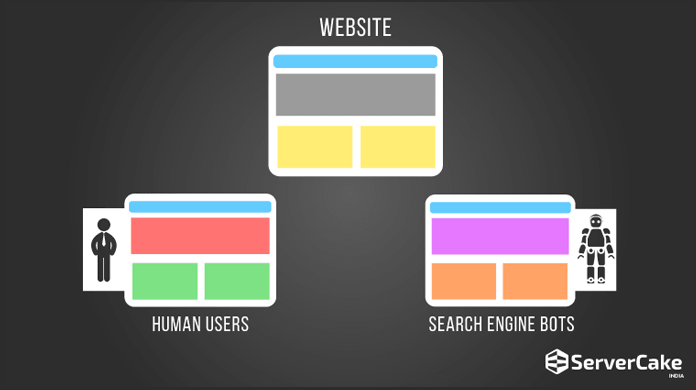Uncover the secret world of cloaking in digital marketing – what it is, how it works, and why it matters.

Image courtesy of via DALL-E 3
Table of Contents
Introduction to Cloaking
In today’s digital age, the Internet is like a massive library where you can find almost anything you want. When we search for information on the web, we rely on websites to provide us with the answers we need. But did you know that some websites play a tricky game called “cloaking”? Let’s dive into this concept and understand what it’s all about.
What is Cloaking?
Cloaking is a clever technique used by some websites to show different content to users compared to what search engines see. Imagine visiting a website and seeing one thing, but when a search engine like Google looks at the site, it sees something completely different. This is the essence of cloaking—it’s like wearing an invisible cloak that hides the true content of a website from search engines.
Why Do People Use Cloaking?
People use cloaking for various reasons, but one common motivation is to try and trick search engines into ranking their websites higher in search results. By showing search engines content that is different from what users actually see, some website owners hope to boost their visibility online. However, this practice is not always ethical, and search engines like Google frown upon such deceptive tactics.
How Cloaking Works
When we talk about cloaking, we’re diving into a world of trickery on the internet that some people use to try and outsmart search engines. But how does this tricky technology actually work? Let’s take a closer look at the nuts and bolts of cloaking.
IP Address
Every device connected to the internet has a unique identifier called an IP address, kind of like a digital fingerprint. Websites can recognize this fingerprint and tailor the content you see based on it. This is how cloaking works behind the scenes – by showing different content to different IP addresses.
User-Agent
Another vital component of cloaking is the user-agent string. This is a tiny piece of information that your device sends to websites to let them know what type of device and browser you’re using. Cloakers can use this user-agent data to decide what content to display, whether it’s for real users or search engine bots.
Types of Cloaking
In the world of the internet, there are different types of cloaking techniques that people use to show websites in a tricky way. Let’s explore a couple of these techniques:

Image courtesy of www.elliance.com via Google Images
Content Cloaking
Content cloaking is a method where websites display different content to search engines than what regular users see. This deceptive practice aims to trick search engines into ranking the site higher because the content shown to them may contain keywords or information that boosts the site’s visibility. This can give the website an unfair advantage over others in search results.
URL Cloaking
URL cloaking involves changing the URLs that users see on a website. This technique is often used to shorten long and messy URLs or to make them look more clean and user-friendly. However, some may misuse this technique to hide the actual destination of a link, leading users to click on links that may not take them where they expect.
Is Cloaking Bad?
In the world of the internet, there’s something called cloaking, and it can be a little tricky. But is it really bad?
Search Engine Policies
When it comes to cloaking, search engines like Google have rules against it. They say that using cloaking to show different content to users and search engines is not fair. It’s like trying to cheat the system to get a higher ranking on search results. Search engines want websites to be honest and show the same content to everyone.
Consequences of Cloaking
If a website gets caught using cloaking, there can be serious consequences. Search engines may lower the website’s ranking or even remove it from search results altogether. This can be harmful to a website’s reputation and traffic, as users may not trust a website that uses dishonest practices like cloaking.
Alternatives to Cloaking
One alternative to cloaking is to focus on creating high-quality, honest content for your website. This means providing valuable information that is relevant to your audience and is not misleading or deceptive. Search engines like Google value websites that offer useful and original content to users. By consistently producing quality content, you can improve your website’s visibility in search results without resorting to cloaking.

Image courtesy of www.pinterest.com via Google Images
Good SEO Practices
Another alternative to cloaking is to implement good SEO practices on your website. This includes using relevant keywords in your content, optimizing your meta tags, creating a user-friendly website design, and building quality backlinks from reputable sources. By following these SEO guidelines, you can improve your website’s ranking in search engine results pages in a legitimate and ethical way.
Real-World Examples of Cloaking
One famous case of cloaking involved the German car manufacturer BMW. In an attempt to improve their search engine rankings, BMW implemented a cloaking strategy that displayed different content to search engines than to regular visitors. When Google discovered this deception, they penalized BMW by removing the website from its search results.
Learning from Mistakes
From this example, we learn that using cloaking techniques to manipulate search engine rankings can have severe consequences. It is essential for websites to focus on creating quality content and following honest SEO practices instead of resorting to deceptive tactics like cloaking.
How to Recognize Cloaking
One way to identify if a website might be using cloaking is by comparing the content that regular users see with what search engines see. If the information displayed to users is significantly different from what search engines can access, there is a possibility that cloaking is being employed. For example, if a website shows a lot of keywords or hidden links to search engines but not to regular visitors, it could be a sign of cloaking.

Image courtesy of www.linkedin.com via Google Images
Using Tools
There are simple tools and methods available that can help in detecting cloaking on websites. Kids can use online tools like “Fetch as Google” which allows them to see a webpage as Google sees it. By using such tools, they can compare the visible content with what search engines are able to crawl and index. Additionally, browser extensions like “User-Agent Switcher” can help in changing the user-agent string of a browser to see if a website displays different content based on this information.
The Future of Cloaking
Cloaking technology is constantly evolving, just like how smartphones get better and faster. In the future, new tricks and methods might be developed to make cloaking even more sneaky and difficult to detect. People who use cloaking will likely try to stay one step ahead of search engines and keep changing their tactics.
Better Detection
On the other side, search engines are getting smarter too. They are working hard to improve their systems and algorithms to catch websites that use cloaking. In the future, it’s possible that search engines will become even better at recognizing when websites are trying to trick them with cloaking. This means that sneaky tactics may not work as well anymore.
Summary and Key Takeaways
In this article, we explored the concept of cloaking, which is a technique used on websites to show different content to users and search engines. Cloaking can be tricky because it involves presenting one version of a website to users and another to search engines. People use cloaking to try and trick search engines into ranking their sites higher.

Image courtesy of www.servercake.blog via Google Images
We delved into the technical aspects of how cloaking works, including how websites recognize users’ IP addresses and use user-agent strings to display different content. We also discussed types of cloaking techniques, such as content cloaking and URL cloaking.
Furthermore, we examined the ethical considerations of cloaking, revealing that search engines like Google have policies against it. Consequences of using cloaking include penalties and being banned from search engine results.
Final Thoughts
Understanding cloaking is crucial because it impacts the integrity of search engine results and website rankings. It is essential to follow good SEO practices and focus on providing quality content to improve search engine visibility honestly.
As technology evolves, the future of cloaking may change. With advancements in technology, we can expect better detection methods from search engines. It is important to stay informed about these developments to ensure fair competition and transparency in online environments.
Want to turn these SEO insights into real results? Seorocket is an all-in-one AI SEO solution that uses the power of AI to analyze your competition and craft high-ranking content.
Seorocket offers a suite of powerful tools, including a Keyword Researcher to find the most profitable keywords, an AI Writer to generate unique and Google-friendly content, and an Automatic Publisher to schedule and publish your content directly to your website. Plus, you’ll get real-time performance tracking so you can see exactly what’s working and make adjustments as needed.
Stop just reading about SEO – take action with Seorocket and skyrocket your search rankings today. Sign up for a free trial and see the difference Seorocket can make for your website!
Frequently Asked Questions (FAQs)
What does cloaking mean in simple terms?
Cloaking is a tricky internet technique used on websites. It means showing different content to users and search engines.
Is cloaking always bad?
Cloaking is usually not a good practice because it can trick search engines and violate their rules. However, there might be some rare situations where cloaking is used for legitimate reasons, like improving user experience.
How can I tell if a website is using cloaking?
You can check for cloaking by comparing what you see on a website with what search engines see. If the content looks different or if there are inconsistencies, the website might be using cloaking. There are also some simple tools available online to help identify cloaking on websites.







